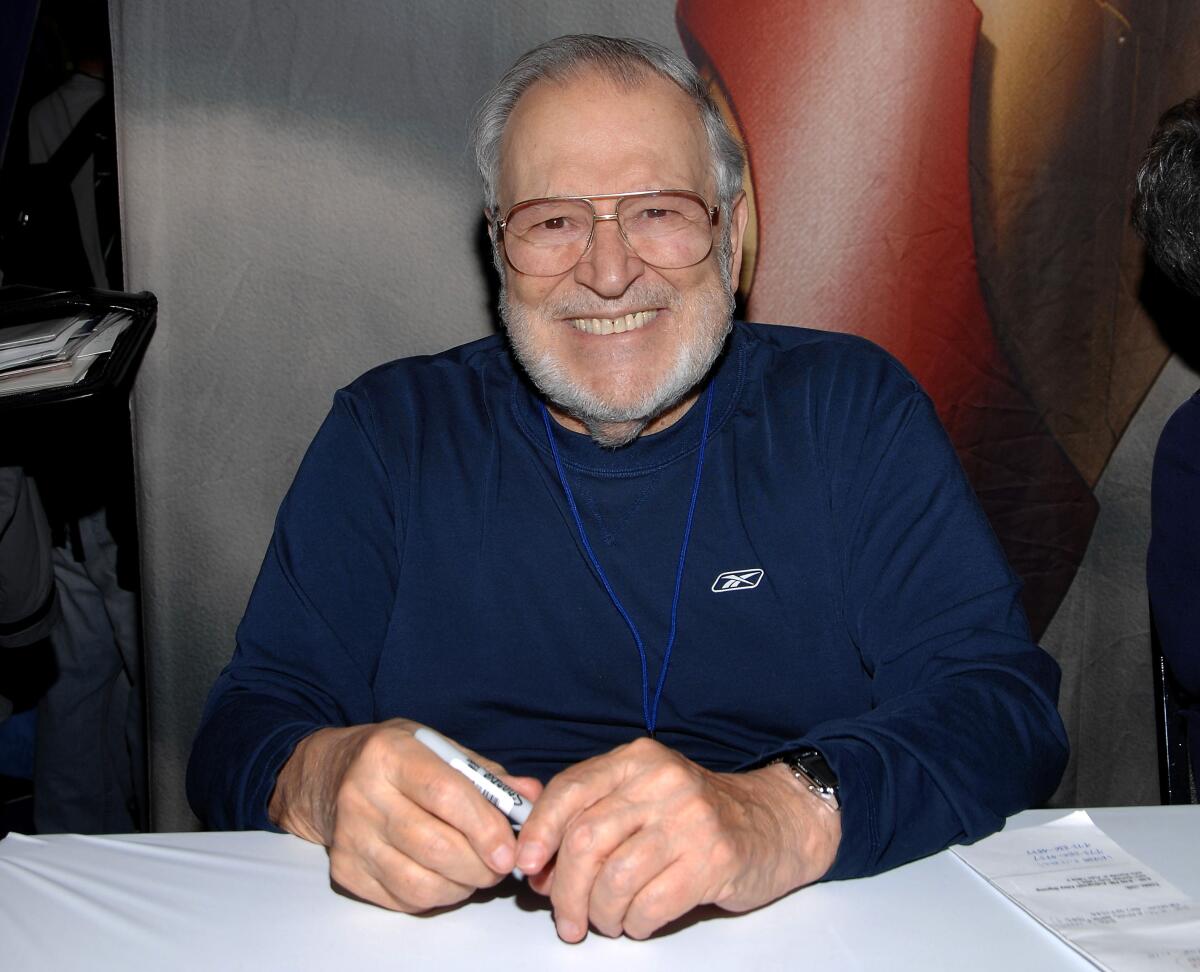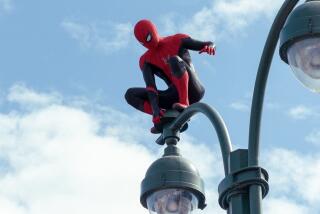John Romita Sr., who drew early ‘Spider-Man’ comics and Wolverine for Marvel, dead at 93

- Share via
Legendary comic book artist John Romita Sr., who worked on timeless early issues of “Spider-Man” and breathed life into Marvel’s Wolverine and Mary Jane Watson with his work, has died at 93.
The artist and art director died “peacefully in his sleep” at his longtime Floral Park, N.Y., home the morning of June 12, said his son comic artist John Romita Jr. on Wednesday. His wife of 70 years, Virginia, 91, was home with him at the time.
Romita Sr., known as “Jazzy” John Romita in the Marvel Bullpen, was the art director of Marvel Comics in the early 1970s and collaborated with late Marvel powerhouse Stan Lee. He also created the younger-skewing “Spidey Super Stories” for the publisher under the tutelage of child psychologists and, in his early years with the company, helped Marvel turn “The Amazing Spider-Man” into its top-selling title.
Naturally, Romita Jr., a Marvel cartoonist who co-created the “Kick-Ass” franchise with Mark Millar, was deeply influenced by his father’s oeuvre. The contemporary “Amazing Spider-Man” artist said that the key to his father’s success was that he was a natural storyteller and brilliant cinephile who frequently described each comic book panel as “basically a stop-action film.”
“He is a legend in the art world and it would be my honor to follow in his footsteps,” Romita Jr. wrote Tuesday on Twitter and Instagram. “He was the greatest man I ever met.”
“[H]is talent defined decades of Marvel’s most well-known storytelling, spanning hundreds of unforgettable comics that brought now iconic characters like Wolverine, Black Widow, the Punisher, Kingpin, Luke Cage, Spider-Man, and Mary Jane to life,” Marvel said in a Tuesday statement.
“Millions came to know Marvel through his art, and millions more came to know Peter Parker through the unmistakable bold brushwork Romita brought to his pages,” the statement said.
“John Romita Sr. was an incomparable artist who brought so many iconic Marvel characters to life on the page and set the tone and look of Marvel’s comics for decades,” added Kevin Feige, president of Marvel Studios. “His version of Spider-Man has inspired so many of us at Marvel Studios. Our thoughts are with his family, and the generations of artists and fans who fell in love with the characters he drew.”
The Brooklyn-born Romita Sr. was a penciler, inker, editor and cover artist for the comic book publisher during a time that the genre, which had been dominated for decades by the style of Captain America creator Jack Kirby, was resurging in the 1960s.
“I don’t consider myself a creator,” said Romita, who retired in 1996, in a 2012 interview with the Comics Reporter. “I’ve created a lot of stuff. But I don’t consider myself a real creator in a Jack Kirby sense. But I’ve always had the ability to improve on other people’s stories, other people’s characters. And I think that’s what’s made me a living for 50 years.”
Romita’s designs were a departure from what had come before and a style that actually made him nervous, added Marvel Entertainment Editor in Chief C.B. Cebulski. But his work defined the look of Peter Parker, Spider-Man, MJ Watson, Gwen Stacy “and everyone else in their orbit.”
“And the same was true for every Marvel character John designed, penciled and inked. Whether as an artist or art director, John’s work influenced generations of comic book artists. With his passing, the comic industry loses a true legend. But just like his artwork, his legacy will remain timeless,” Cebulski added.
Paramount Pictures’ ‘Transformers: Rise of the Beasts’ took on Sony Pictures’ ‘Spider-Man: Across the Spider-Verse’ at the box office this weekend.
Taking over for Spider-Man co-creator Steve Ditko, Romita made his Marvel debut in 1966 drawing the iconic web-slinger for “The Amazing Spider-Man #39” with Art Simek. The 12-cent issue was written by Lee and revealed Norman Osborn as the villainous Green Goblin. As a so-called romance artist, Romita also introduced Spider-Man’s love interest Mary Jane Watson to the franchise, giving the beloved superhero a richer personal life and MJ her own fan following.
“My first impression of Spider-Man was that this was a teenaged Clark Kent with glasses. I said to Stan, ‘This is your number two selling book? I can’t believe it.’ I had never seen Spider-Man before 1965. July of ’65 was the first time I had even heard about it,” Romita said in a 1998 interview with TwoMorrows. “I didn’t even keep an eye on the DC books while I was working there. I don’t know how I stayed in the business. I did not expect comics to last; all of us were expecting to be working in another business in a year. I never kept any of my books; I didn’t keep my ‘Captain America’ books from the ’50s. Frankly, I thought the comic book industry was dying, and what’s the use of worrying about it?”
He went on to work on 50 issues of art, more than 100 covers and on the newspaper strip, said Marvel Entertainment Executive Editor Nick Lowe.
“John defined Spidey for generations of people around the world,” Lowe said. “That would be enough for anyone else, but John was also an excellent art director, a fantastic father, a doting grandfather and a gentleman. All of us making ‘Spider-Man’ comics, and Marvel Comics in general, work in his shadow and strive to live up to the example of the legend Jazzy John Romita.”
John V. Romita was born Jan. 24, 1930, and was the oldest of five children. He was 5 when he started drawing, encouraged to do so at home and in school. He would observe fine artists at Bryant Park sketching with charcoal, and friends even donated chalk so that he could doodle on the Brooklyn sidewalks, where he would draw the Statue of Liberty from one manhole cover to another. He was prouder of his fine art, including a portrait he made of his grandmother, than of his superhero work, Romita Jr. said.
The young artist famously purchased two copies of a “Superman” comic in 1938 to help in his artistic endeavors: one to read and another to use as a drawing guide, Romita Jr. confirmed. However, Romita Sr. often joked that his mother later threw them out. From the time he was 10, he also keenly noticed how Kirby handled the “Captain America” comics differently than others, citing him as an early influence.
He began working as a messenger in Times Square at age 14, making 60 cents an hour while attending the School of Industrial Arts, where he got a commercial education. Romita graduated high school in 1947 and worked in lithography. He got his first break working on recruiting posters for a year and a half during a stint in the Army while he was stationed at Governors Island in New York Harbor. He also worked as a commercial artist for Timely Comics, Marvel’s predecessor.
It was during that time that he had a chance encounter with a friend who worked for Lee as an inker. Romita would surreptitiously sketch comics for that friend, who would then pass them off as his own after going over them with ink — a scheme that lasted for about a year and a half. He gained the nerve to tell Lee about it after he got out of the Army in the 1950s, going uptown in his uniform to present himself to Lee’s secretary and say that he had been working for him for a while without his knowledge. He was immediately given a script to ink, he told the Comics Reporter.
He worked with Lee on the “Captain America” comics in the 1950s and took on the Spider-Man and Daredevil titles of the time. He also plotted for Lee, and while he didn’t work on dialogue, he would be given vague storylines by Lee — who would at times act them out in his office — and “took it to the finish line,” his son said.
“He did not take any offense to any of [Lee’s] largess and his ego — the larger-than-life character,” Romita Jr. said. “My father was a humble and brilliant artist, and they got along famously because my father could put up with [him].”
He met his wife, Virginia, while they were living in tenements when he was 7, and they married in 1952. She also progressed through the Marvel ranks, beginning as an assistant to her husband. She then became an assistant to the editor in chief, a traffic manager and finally a production manager, culminating in the strict production schedule being named after her, Romita Jr. said.
Romita Sr. also worked for rival publisher DC Comics in the 1950s and ’60s on so-called romance books and often worked with “Wonder Woman” writer Bob Kanigher. He continued collaborating with both Lee and Kanigher even after his official retirement.
In a 2020 SyFy interview, Romita said he never truly felt at home on “The Amazing Spider-Man” until his second stint on the book.
“I always felt like a visitor on ‘Spider-Man,’ like I was always doing Ditko somehow,” he said. “I was trying to keep the characters consistent. So I didn’t plunge in there as John Romita, I was doing my duty as Spider-Man. So all the early [issues], I’m doing duty. But by the time [Issues] 108 and 109 [came] around, when I’m doing my second turn on ‘Spider-Man,’ then I’m different. I’m a different person.”
In addition to John Romita Jr., Romita Sr. is survived by his wife, Virginia, and a son named Victor. He also had three grandchildren and one great-granddaughter.
More to Read
Sign up for our Book Club newsletter
Get the latest news, events and more from the Los Angeles Times Book Club, and help us get L.A. reading and talking.
You may occasionally receive promotional content from the Los Angeles Times.











